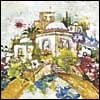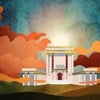Dear Rabbi,
I read, with great interest, chapters 40-48 of Ezekiel in the Bible. Is it true that the Jews never built the Temple that is described there?
If it is true, why did the Jews disregard Ezekiel’s prophecy when they built the second Temple?
And why was it relevant for the prophet to describe, in great detail, something that they didn’t even end up building?
Answer:
It was in the twenty-fifth year of the Babylonian exile that Ezekiel prophesied that the Holy Temple would be rebuilt. The prophecy spans a number of chapters, describing in great detail how this future Temple would look.1 And yet, when we look at the descriptions of the second Temple, we see that it was not built according to those specifications.2
The famed commentator, Rabbi Sholomo Yitzchaki (Rashi), quotes from the sages to explain these verses:
The second ascent to the Holy Land of Israel during the time of Ezra was meant to be like the first entry through Joshua—to come about by force and through a miracle. This is what the Talmud states,3 bringing proof from the verse where it states twice [the words] “cross over,” “Your people cross over, O G‑d, until this nation that You have acquired crosses over.”4
This building would have been fit for them then, when they emerged from exile, had there been an everlasting redemption. However, their sin caused this to not happen; for their repentance was not suitable. In other words, they did not resolve to stop sinning. Therefore, they were freed only through the sanction of Cyrus and his son.
Some say that their sin in Babylon was that they stumbled regarding gentile women.5
This, explain the commentators, is the reason why they did not build the second Temple according to the specifications in the prophecy in Ezekiel. That Temple was to be an everlasting edifice, as the verse there states, “and I shall dwell among them forever.”6 Instead, when it came time to rebuild the second Temple, G‑d commanded through his prophets Chaggai, Zechariah and Malachi not to build it according to the specifications in Ezekiel.7
Indeed, when the Rabbis referred to the second Temple period, they would say it was a partial redemption only. For not only were the Jews still under foreign rule, but the second Temple also lacked some key components—including the Holy Ark.8
However, even though the second Temple did not have the everlasting quality of the Temple of Ezekiel’s prophecy, the builders did incorporate certain parts of the prophecy into its construction. 9
In commanding Ezekiel to describe the dimensions of the Temple to the Jewish people, G‑d says,
You, son of man, describe the House to the House of Israel, that they may be ashamed of their iniquities; let them measure its plan. And if they are ashamed of all that they have done, let them know the form of the House and its scheme, its exits and its entrances, and all its forms, and all its laws and all its teachings, and write it down in their sight so that they keep the whole form thereof and the laws thereof, and do them.10
The Sages in the Midrash explain that when Ezekiel heard this, he turned to G‑d and asked,
What is the point of saying this to the Jewish people if they are in exile and will not build this Temple now? Let me wait until they are redeemed and then I will tell them this prophecy.
G‑d replied,
Just because my children are in exile there should be no building of My House?! Learning in the Bible about the description of My House is as great as the building of it. Go and tell the Jewish people to occupy themselves in learning about the Temple, and in that merit I will consider it as if they are actually involved in building it.11
The Lubavitcher Rebbe, Rabbi Menachem Mendel Schneerson, of righteous memory, adds that from here we see how important it is to learn the laws of the Holy Temple; for through this, not only do we fulfill, even during the exile, the commandment to build the Holy Temple, but we actually weaken the concept of its destruction, and we ultimately merit its rebuilding with the coming of the messianic era, may it be speedily in our days.12
See a tour of The Second Holy Temple in Jerusalem.
Rabbi Yehuda Shurpin
Ask the Rabbi @ The Judaism Website – Chabad.org





Join the Discussion